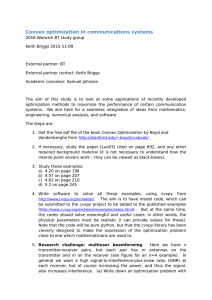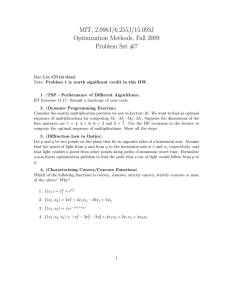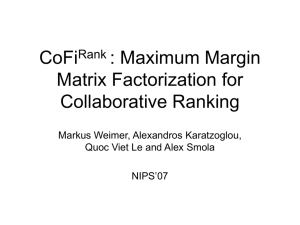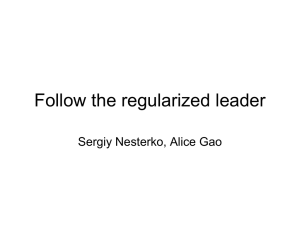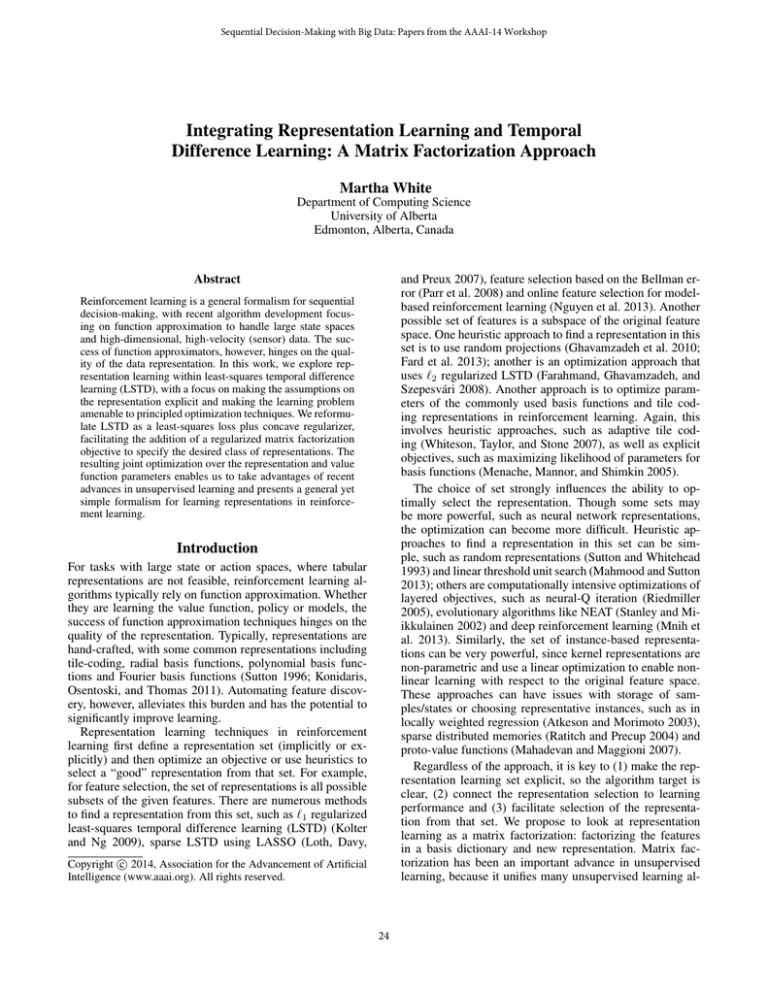
Sequential Decision-Making with Big Data: Papers from the AAAI-14 Workshop
Integrating Representation Learning and Temporal
Difference Learning: A Matrix Factorization Approach
Martha White
Department of Computing Science
University of Alberta
Edmonton, Alberta, Canada
Abstract
and Preux 2007), feature selection based on the Bellman error (Parr et al. 2008) and online feature selection for modelbased reinforcement learning (Nguyen et al. 2013). Another
possible set of features is a subspace of the original feature
space. One heuristic approach to find a representation in this
set is to use random projections (Ghavamzadeh et al. 2010;
Fard et al. 2013); another is an optimization approach that
uses `2 regularized LSTD (Farahmand, Ghavamzadeh, and
Szepesvári 2008). Another approach is to optimize parameters of the commonly used basis functions and tile coding representations in reinforcement learning. Again, this
involves heuristic approaches, such as adaptive tile coding (Whiteson, Taylor, and Stone 2007), as well as explicit
objectives, such as maximizing likelihood of parameters for
basis functions (Menache, Mannor, and Shimkin 2005).
The choice of set strongly influences the ability to optimally select the representation. Though some sets may
be more powerful, such as neural network representations,
the optimization can become more difficult. Heuristic approaches to find a representation in this set can be simple, such as random representations (Sutton and Whitehead
1993) and linear threshold unit search (Mahmood and Sutton
2013); others are computationally intensive optimizations of
layered objectives, such as neural-Q iteration (Riedmiller
2005), evolutionary algorithms like NEAT (Stanley and Miikkulainen 2002) and deep reinforcement learning (Mnih et
al. 2013). Similarly, the set of instance-based representations can be very powerful, since kernel representations are
non-parametric and use a linear optimization to enable nonlinear learning with respect to the original feature space.
These approaches can have issues with storage of samples/states or choosing representative instances, such as in
locally weighted regression (Atkeson and Morimoto 2003),
sparse distributed memories (Ratitch and Precup 2004) and
proto-value functions (Mahadevan and Maggioni 2007).
Regardless of the approach, it is key to (1) make the representation learning set explicit, so the algorithm target is
clear, (2) connect the representation selection to learning
performance and (3) facilitate selection of the representation from that set. We propose to look at representation
learning as a matrix factorization: factorizing the features
in a basis dictionary and new representation. Matrix factorization has been an important advance in unsupervised
learning, because it unifies many unsupervised learning al-
Reinforcement learning is a general formalism for sequential
decision-making, with recent algorithm development focusing on function approximation to handle large state spaces
and high-dimensional, high-velocity (sensor) data. The success of function approximators, however, hinges on the quality of the data representation. In this work, we explore representation learning within least-squares temporal difference
learning (LSTD), with a focus on making the assumptions on
the representation explicit and making the learning problem
amenable to principled optimization techniques. We reformulate LSTD as a least-squares loss plus concave regularizer,
facilitating the addition of a regularized matrix factorization
objective to specify the desired class of representations. The
resulting joint optimization over the representation and value
function parameters enables us to take advantages of recent
advances in unsupervised learning and presents a general yet
simple formalism for learning representations in reinforcement learning.
Introduction
For tasks with large state or action spaces, where tabular
representations are not feasible, reinforcement learning algorithms typically rely on function approximation. Whether
they are learning the value function, policy or models, the
success of function approximation techniques hinges on the
quality of the representation. Typically, representations are
hand-crafted, with some common representations including
tile-coding, radial basis functions, polynomial basis functions and Fourier basis functions (Sutton 1996; Konidaris,
Osentoski, and Thomas 2011). Automating feature discovery, however, alleviates this burden and has the potential to
significantly improve learning.
Representation learning techniques in reinforcement
learning first define a representation set (implicitly or explicitly) and then optimize an objective or use heuristics to
select a “good” representation from that set. For example,
for feature selection, the set of representations is all possible
subsets of the given features. There are numerous methods
to find a representation from this set, such as `1 regularized
least-squares temporal difference learning (LSTD) (Kolter
and Ng 2009), sparse LSTD using LASSO (Loth, Davy,
c 2014, Association for the Advancement of Artificial
Copyright Intelligence (www.aaai.org). All rights reserved.
24
policy π : S × A → [0, 1] from a given state st :
V π (st ) =
#
"∞
X
k
E
γ R(st+k ) si ∼ P (·|si−1 , ai−1 ), ai ∼ π(·|si )
gorithms into one framework (Xu, White, and Schuurmans
2009; White and Schuurmans 2012; De la Torre 2012), including (exponential family) principal components analysis, k-means clustering, mixture model clustering, canonical correlation analysis and normalized graph cut. Moreover, there have been important advances in convex formulations for a restricted class of matrix factorization problems (Bach, Mairal, and Ponce 2008; Zhang et al. 2011;
White et al. 2012), facilitating optimization for at least two
important classes of representation learning: sparse coding
and subspace learning.
In this work, we show how to extend LSTD to include
an unsupervised, matrix factorization component that ports
these advances to reinforcement learning. Regularized matrix factorization clarifies the assumptions on the data distribution (from the chosen loss) and structure of the representation (from the chosen regularizer). In addition to making the
representation set explicit and facilitating optimization, our
proposed joint objective over the representation and value
function function parameters connects the representation selection to prediction performance.
Our main contributions are
k=0
This value function satisfies the Bellman equation
X
X
P (s0 |s, a)V π (s0 ) (1)
V π (s) = R(s) + γ
π(a|s)
s0
a
For a finite number of states and actions, this formula can be
re-expressed in terms of matrices and vectors for each state
V π = R + γP π V π
where V π , R ∈ Rn are vectors of state values and rewards,
and P π ∈ Rn×n is the probability of transitioning between
two states under policy π
X
π
Pi,j
=
π(a|s = i)P (s0 = j|s = i, a)
a
Given the reward function and transition probabilities, the
solution can be analytically obtained: V π = (I −γP π )−1 R.
In practice, however, we likely have a prohibitively large
state-action space. The typical strategy in this setting is to
use function approximation to learn V π (s) from a trajectory of samples: a sequence of states, actions, and rewards
s0 , a0 , r0 , s1 , a1 , r1 , s2 , r2 , a2 . . ., where s0 is drawn from
the start-state distribution, st+1 ∼ P (·|st , at ) and at ∼
π(·|st ). Commonly, a linear function is assumed:
1. a novel formulation of LSTD as the combination of a
least-squares loss and concave regularizer on the value
function parameters (giving a new loss called the CRTD);
2. an explicit joint optimization over the value function parameters and the representation that is amenable to known
optimization techniques.
V̂ π (s) = φT (s)w
for w ∈ Rk a parameter vector and φ : S → Rk a feature
function describing states. With this approximation, however, typically we can no longer satisfy the Bellman equation
in (1), since solving for Φw = R+γP π Φw with Φ ∈ Rn×k
may not be defined if Φ is not invertible. Reinforcement
learning algorithms, such as LSTD, therefore focus on finding an approximate solution to the Bellman equation, despite
this representation issue.
The resulting approach removes the need for matrix inversion that can be a problem in LSTD, since the algorithm is
a stochastic minimization of an objective function. Moreover, the representation learning component remains general, since matrix factorization encompasses many options
for the representation depending on the chosen constraints.
Least-Squares Temporal Difference Learning
Background
LSTD finds the minimum of the mean-square projected
Bellman error (MSPBE) (Sutton et al. 2009):
min kΦw − Π(R + γP π Φw)k2D
(2)
In reinforcement learning, an agent interacts with its environment, receiving observations and selecting actions to
maximize a scalar reward signal provided by the environment. This interaction is usually modeled by a Markov decision process (MDP). An MDP consists of (S, A, P, R)
where S is the set of states; A is a finite set of actions; P , the
transition function, which describes the probability of reaching a state s0 from a given state and action (s, a); and finally
the reward function R(s0 ), which returns a scalar value for
transitioning from state-action (s, a) to state s0 . The state of
the environment is said to be Markov if P r(st+1 |st , at ) =
P r(st+1 |st , at , . . . , s0 , a0 ).
w∈Rk
n×n
where D ∈ [0, 1]
is a diagonal matrix giving the distribution over states, ||z||2D = zT Dz and the projection matrix
for linear value functions is Π = Φ(ΦT DΦ)−1 ΦT D.
For simplicity, we first present LSTD and our representation learning extension assuming that we have the transition
model and reward function. We describe how to move to a
trajectory of samples in the last section.
The closed-form solution for this loss is the solution to the
following linear system (Bradtke and Barto 1996):
−1 T
w = ΦT DΦ
Φ D (R + γΦ0 w)
Learning a Value Function
=⇒ ΦT D (Φ − γP π Φ) w = |ΦT{z
DR}
|
{z
}
One important goal in reinforcement learning is to learn the
value function for a policy. A value function approximates
the expected total discounted future reward for following
A
b
Given samples, LSTD forms approximations to the matrices A and b and solves the system w = A−1 b.
25
Factorized representation learning for LSTD
where
We now show that LSTD corresponds to the minimization
of a squared loss plus a concave regularizer.
|||Z|||∗ = min
U ∈U
is the induced regularizer given the regularizer on Φ. We
can simplify further using Y = [R X] and e1 = [1 0 . . . 0],
giving
min ||Φw − R||2D − 2γwT ΦT DP π Φw
w
∇w = (ΦT DΦ)w − ΦT DR − γΦT DP π Φw = 0
min L(Z, Y ) − γeT1 Z T DP π Ze1 + α|||Z|||∗
=⇒ (ΦT DΦ − γΦT DP π Φ)w = ΦT DR
T
π
T
=⇒ Φ D(Φ − γP Φ)w = Φ DR
Z
(LSTD)
min
L(ΦB, X) + α||Φ||
where L is any convex loss, X ∈ Rn×d is the default (expanded) feature set, B ∈ B ⊂ Rk×d is a learned basis dictionary and α is the weight on the regularizer. For example, X
could be all cross products of the observations, and Φ could
be a subset of these expanded features. The structure of the
learned representation Φ, depends on the chosen regularizer,
|| · ||. For example, ||Φ||1,1 imposes sparsity and ||Φ||1,2 imposes a subspace structure to reduce the dimension of the
representation. Both of these forms can be useful for dealing with high-dimensional , high-volume data.
We obtain the following Factorized-Representation
CRTD (FR-CRTD) optimization, where we overload f , for
convenience:
min
w,Φ,B∈B
Minimizing the concave-convex FR-CRTD loss
||Φw − R||2D − γf (w, Φ) + L(ΦB, X) + α||Φ||
Once we have this concave-convex form, there are several
optimization strategies that we can explore. First, we can
use the concave-convex procedure (CCCP) (Yuille and Rangarajan 2002). CCCP linearizes the concave component on
each iteration, to make the problem convex (Sriperumbudur
and Lanckriet 2009). In this setting, the CCCP algorithm that
minimizes (4) would be:
This new joint optimization combines a supervised and unsupervised loss, directing representation learning based both
on the desired structure and on prediction performance. For
a fixed representation, Φ, the optimization reduces to LSTD.
Improved optimization for FR-CRTD
Z (l+1) ∈ arg minZ L(Z, Y ) − 1T Z ◦ ∇R(Z (l) )1
Let U = [w B] ∈ U, where U is a constraint set on U . We
use a change of variables, Z1 = Φw, Z2 = ΦB to obtain a
simpler optimization.
min
||Φw − R||2D − γwT ΦT DP π Φw
+L(ΦB, X) + α||Φ||
U =[w B]∈U ,Φ
(4)
where L now contains both the loss between ΦB and X and
the loss between Φw and R.
Recent advances in (semi-supervised) matrix factorization (Bach, Mairal, and Ponce 2008; Zhang et al. 2011;
White et al. 2012) indicate that the induced regularizer ||| · |||
is convex as long as the regularizer on Φ sums over all latent
Pk
features, i.e. i=1 ||Φ:,i || where 1 ≤ k ≤ ∞ and for a restricted class of constraint sets, U. See the Appendix for a list
of efficiently computable convex induced regularizers on Z.
Though this list is currently quite restricted, FR-CRTD does
not rely on the above set and can advance as more efficiently
computable induced regularizers are discovered. The ability
to benefit from advances in the large field of unsupervised
learning is a strong benefit of FR-CRTD.
The resulting optimization over Z = [Z1 Z2] is the addition of a convex problem with a concave regularizer. Though
this optimization seems difficult, minimization of concaveconvex problems has been studied, which we leverage in the
next section to find an efficient optimization approach.
Once we obtain Z, we can use a boosting procedure to recover the parameters U and Φ (Zhang, Yu, and Schuurmans
2012). For certain settings, it is more simple; for example,
for U = {U : ||Ui,: ||2 ≤ 1} and ||Φ||1,2 the recovery is simply a singular value decomposition: for Z = QΣM T with
Q and M orthonormal and Σ a diagonal matrix of singular
values, U = M T and Φ = QΣ. Since the recovery procedures rely only on the regularizer on Φ, they apply to this
setting despite the addition of the concave component.
We call ||Φw − R||2D − 2γwT ΦT DP π Φw the ConcaveRegularized-TD (CRTD) loss and distinguish it from the
MSPBE because they are not equivalent, even though the
minimization of the two losses results in the same solution (see the Appendix for the difference). Unfortunately, the
minimization over w for this loss is not a convex optimization, since f (w) = wT ΦT DP π Φw is convex (making the
negative of the function concave)1 .
This form does, however, facilitate specifying representation learning in terms of regularization strategies used in
unsupervised learning. In particular, we can add a regularized matrix factorization loss to find a representation:
Φ∈Rn×k ,B∈B
min ||Φ||
Φ:ΦU =Z
where R(Z) = γeT1 Z T DP π Ze1 , ◦ is the component-wise
product and the inner product with 1 on either sides sums all
the entries. Because energy functions can be decomposed
into a convex plus concave function (Yuille and Rangarajan
2002), there may also be more specific algorithms available
to more efficiently solve our concave-convex problem.
Another potential option is to reformulate the objective
to enable use of global solution methods that minimize a
concave objective with convex constraints (Hoffman 1981).
This would require formulating the equivalent constrained
(3)
≡ min ||Z1 − R||2D − γZ1T DP π Z1 + L(Z2 , X) + α|||Z|||∗
Z=[Z1 Z2]
1
f (w) is convex since it is the composition of a linear function,
Φw, and a convex function, the `2 norm.
26
The first natural question is about the generality of this
approach. Because the set of regularizers on Φ to obtain a
convex formulation is limited, this suggests few structures
can be chosen. If we do not require convexity, however, we
can use a wider class of regularizers in Equation (3). For
example, if we wanted to learn a representation similar to tile
coding, we could add the constraint that Φ ∈ [0, 1] and use
a large regularizer weight on a sparsity regularizer to push
most entries to zero. This optimization is no longer convex,
but we can still optimize the non-convex objective over the
variables w, B and Φ.
In addition, we can notice an interesting generalization
of LSTD by generalizing the least-squares loss on the reward prediction to any convex loss in Equation (4). If we
choose a Bregman divergence, for example, this generalization suggests certain distributional assumptions on the reward (White and Schuurmans 2012). The relationship to the
original fixed-point problem, however, becomes unclear and
requires further exploration.
Second, it is important to notice that FR-CRTD maintains the fixed-point interpretation of LSTD. A complaint
about the sparse LASSO approach to LSTD (Loth, Davy,
and Preux 2007) was that the fixed-point interpretation was
lost after adding a sparse regularizer. In this situation, however, if we compute and fix the representation in the inner
optimization, we are simply doing an LSTD outer optimization.
Third, we need to consider computational complexity,
which is typically a large consideration for high-velocity,
high-dimensional data that occurs in realistic sequential
decision-making tasks. The types of representations the formalism specifies, such as sparse or subspace representations,
is key for high-dimensional data. The current algorithms for
this objective, however, have poor computational complexity. One strategy is to develop an online approach for optimizing FR-CRTD, which has been possible for several regularized matrix factorization problems (Warmuth and Kuzmin
2008; Mairal et al. 2010). Generally, however, there has been
little development of online algorithms for regularized matrix factorization; this is likely the most crucial research direction for making FR-CRTD a practical option.
Finally, viewing LSTD as a least-squares loss plus concave regularizer provides a new intuition. Maximizing the
inner product corresponds to finding vectors pointing in the
same direction. LSTD, therefore, is balancing minimizing
the angle between the current and next state values and predicting the reward for the current state.
Overall, formalizing representation learning as a matrix
factorization facilitates extending recent and upcoming advances in unsupervised learning to the reinforcement learning setting. The generality of the approach and easy to understand optimization make it a promising direction for representation learning in reinforcement learning.
optimization, which moves the convex component of the
loss to a constraint: minZ:L(Z,Y )+α|||Z|||∗ −c≤0 −R(Z). The
effectiveness of this optimization approach is left for future
research, but could be a promising avenue for convex, generalized representation learning for reinforcement learning.
Learning from samples
To practically deal with real-world streams of data and large
state-spaces, we cannot assume we have explicit knowledge
of the (large) transition model P π and R. Though these
could be learned, it is often desirable to be able to solve the
parameters without needing to find these models.
To avoid using the models, we define matrices approximated from sampled quartets (si , ai , ri , s0i )
φ(s01 )T
φ(s1 )T
r1
0 T
φ(s2 )T
r2
0 φ(s2 )
Φ̄ ≡
, Φ̄ ≡
, R̄ ≡
..
..
...
.
.
rt
φ(st )T
φ(s0t )T
For LSTD, we can express the closed form solution in
terms of these approximate matrices:
−1 T
w = Φ̄T Φ̄
Φ̄ R̄ + γ Φ̄0 w
Importantly, it has been shown that, as t → ∞, the
fixed point for this approximate problem converges to the
fixed point of the original problem (2), with probability
one (Bradtke and Barto 1996).
Moving to samples is more complicated for FR-CRTD,
since we cannot use the matrix of next features, Φ0 . To avoid
learning Φ0 , we need P̂ π such that P̂ π Φ̂ = Φ̂0 . Fortunately,
this linear transformation is quite simple in practice, since
Φ̂0 is Φ̂ shifted by one index. Of course, we do not have
access to the last vector in Φ̂0 , but we can simply drop that
last sample as a reasonable approximation to the loss.
Define
0 1 0 ... 0
0 0 1 ... 0
..
π
.
P̂ =
0 ... 0 1 0
0 ... 0 0 1
0 ... 0 0 0
The resulting model-free FR-CRTD optimization for Ŷ =
[R̂ X̂] can now be stated as:
min L(Z, Ŷ ) − γeT1 Z T P̂ π Ze1 + α|||Z|||∗
Z
The samples, unfortunately, will not always be perfectly
aligned or in order, such as is the case when multiple
episodes or trajectories are obtained. Again, we can ignore
constraints across boundaries, but in general, the problem of
estimating P̂ π is an important avenue for future work.
Acknowledgements
Discussion
This work was supported by grants from Alberta Innovates
Technology Futures and the National Science and Engineering Research Council of Canada.
Several interesting questions arise from viewing LSTD and
representation learning under the FR-CRTD optimization.
27
References
Riedmiller, M. 2005. Neural fitted Q iteration – first experiences
with a data efficient neural reinforcement learning method. In Machine Learning: ECML 2005.
Sriperumbudur, B. K., and Lanckriet, G. 2009. On the convergence
of the concave-convex procedure. In Advances in Neural Processing Systems.
Stanley, K. O., and Miikkulainen, R. 2002. Efficient evolution of
neural network topologies. In Proceedings of the 2002 Congress
on Evolutionary Computation.
Sutton, R., and Whitehead, S. 1993. Online learning with random
representations. In Proceedings of the Tenth International Conference on Machine Learning.
Sutton, R.; Maei, H.; Precup, D.; and Bhatnagar, S. 2009. Fast
gradient-descent methods for temporal-difference learning with
linear function approximation. Proceedings of the 26th International Conference on Machine Learning.
Sutton, R. 1996. Generalization in reinforcement learning: Successful examples using sparse coarse coding. Advances in Neural
Information Processing Systems.
Warmuth, M. K., and Kuzmin, D. 2008. Randomized online PCA
algorithms with regret bounds that are logarithmic in the dimension. Journal of Machine Learning Research.
White, M., and Schuurmans, D. 2012. Generalized optimal reverse
prediction. In Proceedings of the 15th International Conference on
Artifical Intelligence and Statistics.
White, M.; Yu, Y.; Zhang, X.; and Schuurmans, D. 2012. Convex
multi-view subspace learning. In Advances in Neural Information
Processing Systems.
Whiteson, S.; Taylor, M. E.; and Stone, P. 2007. Adaptive tile coding for value function approximation. Technical report, University
of Texas at Austin.
Xu, L.; White, M.; and Schuurmans, D. 2009. Optimal reverse
prediction: a unified perspective on supervised, unsupervised and
semi-supervised learning. In Proceedings of the 26th International
Conference on Machine Learning.
Yuille, A. L., and Rangarajan, A. 2002. The concave-convex procedure (CCCP) . In Advances in Neural Information Processing
Systems.
Zhang, X.; Yu, Y.; White, M.; Huang, R.; and Schuurmans,
D. 2011. Convex sparse coding, subspace learning, and semisupervised extensions. In Proceedings of the 25th AAAI Conference on Artificial Intelligence.
Zhang, X.; Yu, Y.; and Schuurmans, D. 2012. Accelerated training
for matrix-norm regularization: A boosting approach. In Advances
in Neural Information Processing Systems.
Atkeson, C. G., and Morimoto, J. 2003. Nonparametric representation of policies and value functions: a trajectory-based approach.
In Advances in Neural Information Processing Systems.
Bach, F.; Mairal, J.; and Ponce, J. 2008. Convex sparse matrix
factorizations. arXiv.org.
Bradtke, S. J., and Barto, A. G. 1996. Linear least-squares algorithms for temporal difference learning. Machine Learning.
De la Torre, F. 2012. A least-squares framework for component
analysis. IEEE Transactions on Pattern Analysis and Machine Intelligence.
Farahmand, A. M.; Ghavamzadeh, M.; and Szepesvári, C. 2008.
Regularized policy iteration. In Advances in Neural Information
Processing Systems.
Fard, M. M.; Grinberg, Y.; Farahmand, A. m.; Pineau, J.; and Precup, D. 2013. Bellman error based feature generation using random projections on sparse spaces. Advances in Neural Information
Processing Systems.
Ghavamzadeh, M.; Lazaric, A.; Maillard, O. A.; and Munos, R.
2010. LSTD with random projections. In Advances in Neural Information Processing Systems.
Hoffman, K. L. 1981. A method for globally minimizing concave
functions over convex sets. Mathematical Programming.
Kolter, J., and Ng, A. 2009. Regularization and feature selection in
least-squares temporal difference learning. In Proceedings of the
26th Annual International Conference on Machine Learning.
Konidaris, G.; Osentoski, S.; and Thomas, P. S. 2011. Value function approximation in reinforcement learning using the Fourier basis. In Proceedings of the Twenty-Fifth AAAI Conference on Artificial Intelligence.
Loth, M.; Davy, M.; and Preux, P. 2007. Sparse temporal difference learning using LASSO. In IEEE International Symposium on
Approximate Dynamic Programming and Reinforcement Learning.
Mahadevan, S., and Maggioni, M. 2007. Proto-value functions:
a Laplacian framework for learning representation and control in
Markov decision processes. Journal of Machine Learning.
Mahmood, A. R., and Sutton, R. 2013. Representation search
through generate and test. In Proceedings of the AAAI Workshop
on Learning Rich Representations from Low-Level Sensors.
Mairal, J.; Bach, F.; Ponce, J.; and Sapiro, G. 2010. Online Learning for Matrix Factorization and Sparse Coding. Journal of Machine Learning Research.
Menache, I.; Mannor, S.; and Shimkin, N. 2005. Basis function
adaptation in temporal difference reinforcement learning. Annals
of Operations Research.
Mnih, V.; Kavukcuoglu, K.; Silver, D.; Graves, A.; Antonoglou, I.;
Wierstra, D.; and Riedmiller, M. 2013. Playing Atari with deep
reinforcement learning. arXiv.org.
Nguyen, T.; Li, Z.; Silander, T.; and Yun Leong, T. 2013. Online
feature selection for model-based reinforcement learning. Journal
on Machine Learning.
Parr, R.; Li, L.; Taylor, G.; and Painter-Wakefield, C. 2008. An
analysis of linear models linear value function approximation and
feature selection for reinforcement learning. In Proceedings of the
Twenty-Fifth International Conference on Machine Learning.
Ratitch, B., and Precup, D. 2004. Sparse distributed memories for
on-line value-based reinforcement learning. In Machine Learning:
ECML 2004.
28
Appendix
Relationships between the CRTD and the MSPBE
Even though the minimization of the FR-CRTD is equivalent to the minimization of the MSPBE, they are themselves not
equivalent. The difference becomes clear when we explicitly write out the MSPBE loss. Recall that the projection operator in the
MSPBE is Π = Φ(ΦT DΦ)−1 ΦT D, the Bellman operator is T V = (R+γP V ) and the M SP BE(V ) = ||V −ΠT V ||2D (Sutton
et al. 2009). We will use the following simplifications
DΦ(ΦT DΦ)−1 ΦT D = D
T
since ΦT (DΦ(ΦT DΦ)−1 ΦT D) = ΦT D
T
T
Φ DΠ = Φ D
T
since Φ D(Φ(Φ DΦ)
T
Π DΦ = DΦ
−1
Π DΠ = D
Φ D) = Φ D
(6)
T
T
T
(7)
T
T
−1
since Π = DΦ(Φ DΦ)
T
T
Π DΠ = DΦ(Φ DΦ)
T
(5)
T
T
T
since Π DΦ = (Φ DΠ) = (Φ D) = DΦ
T
T
T
T
w Φ D(T Φw) = (T Φw) DΦw
−1
T
Φ giving
(8)
T
T
−1
Φ DΠ = DΦ(Φ DΦ)
T
Φ D=D
since this in an inner product
(9)
Now we can write out the MSPBE with some simplifications
M SP BE(w) = ||Φw − Π(T Φw)||2D
= (wT ΦT − (T Φw)T ΠT )D(Φw − ΠT Φw)
T
DΠ} T Φw
= wT ΦT DΦw − wT Φ
DΠ} T Φw − (T Φw)T |ΠT{z
DΦ} w + (T Φw)T |ΠT{z
| {z
T
T
T
DΦ
ΦT D
T
T
D
T
T
T
= w Φ DΦw − 2w Φ D(R + γP Φw) + (R + γw Φ P )D(R + γP Φw)
= wT ΦT DΦw − 2wT ΦT DR − 2γwT ΦT DP Φw + RT DR
+ γRT DP Φw + γwT ΦT P T DR + γ 2 wT ΦT P T DP Φw
Notice that the first part of the last equality is actually the CRTD! So, we can write
M SP BE(w) = CRT D(w) + 2γwT ΦT P T DR + γ 2 wT ΦT P T DP Φw
Since the minimization of CRTD leads to the same solution as minimizing the MSPBE (as their minimum both corresponds
to the LSTD solution), this last factor should not influence the chosen w. Interestingly, these last components are on the next
state value (i.e. P Φw), so intuitively, it is possible that they may not be needed for choosing the best params for this state value.
List of known convex induced regularizers
The introduced matrix factorization approach for representation learning formalized the approach using a constraint set on B
and a regularizer on Φ. Interestingly, it can equivalently be formulated without constraints and instead regularizers on both
parameters (Bach, Mairal, and Ponce 2008).
Regardless of the choice, the list of tractable induced norms remains the same. The following constitute some of the known
(and used) regularizer and constraint set options that result in an efficient, closed-form induced regularizer on Z:
T
1. The regularizer ||Φ||1,1 is chosen for sparsity. For U = {U : ||Ui,:||q ≤ 1}, the induced norm
is ||Z ||q,1 . For U = {[w B] :
P
1
||w||q1 ≤ 1, ||Bi,: ||q2 ≤ β}, the induced norm on Z is j max ||Z1T ||1,q1 , β ||Z2T ||1,q2 . Previously, these induced norms
lead to trivial vector quantization solutions (Zhang et al. 2011); with the concave regularizer, this may no longer be the case.
2. The regularizer ||Φ||1,2 is chosen for subspace learning. For U = {U : ||Ui,: ||2 ≤ 1}, the induced norm is ||Z||tr . For
U = {[w B] : ||w||2 ≤ 1, ||Bi,: ||2 ≤ β}, the induced norm on Z is max0≤η≤1 ||Z||tr .
3. The regularizer ||Φ||1,p can be useful to push down large values. The `∞ norm is used to bound maximum values, and as p
gets larger, `p approaches the `∞ norm. For 1 < p < 2, we could also imagine some blended behaviour between p = 1 and
p = 2. In general, however, p 6= 1, 2, ∞ is not commonly used. If it is chosen, then for U = {U : ||Ui,: ||1 ≤ 1}, the induced
norm is ||Z||p,1
29

